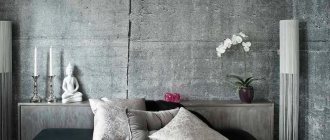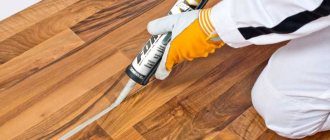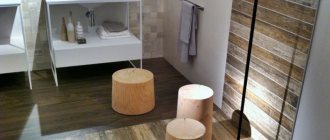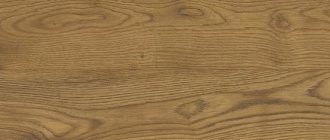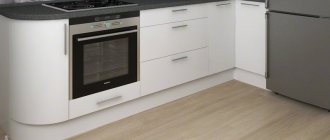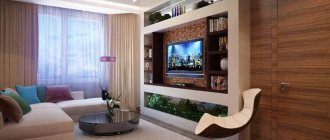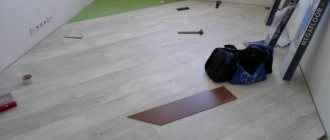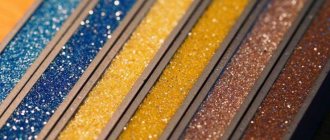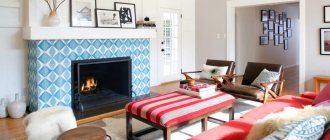The popularity of laminate, which it acquired almost from the first days of its appearance on store shelves, can be explained by quite ordinary reasons - it is easy to install and maintain, has an excellent appearance, is capable of partial repairs, and you can do the laying of laminate yourself, without turning to outside specialists.
In addition, the surface of the laminate is warm and pleasant to the senses, which is important, especially in the off-season.
But the most important advantage of the material is its ability to be laid on old coatings that there is no desire or need to dismantle.
In some cases this can be very convenient, especially if dismantling the old material will lower the floor level too much.
Some types of old coatings serve as a high-quality basis for the laminate, increasing its performance.
Let's take a closer look at the question.
Is it possible to lay laminate flooring on linoleum?
This question is often asked on various online platforms. Doubts about this are a consequence of the unpreparedness of people who have little understanding of the technology of laying laminate flooring. It states that the base must be dry, clean and level.
If linoleum meets these requirements, then installation can be carried out without fear . At the same time, the evenness of the surface cannot be checked by eye, since the linoleum sheet always looks quite smooth and flat. But in reality there may be significant differences that are unacceptable when installing laminate flooring.
At the same time, the linoleum layer can be considered as a kind of substrate that provides an elastic gasket between the subfloor and the new coating. It helps to correct small potholes or bulges in the floor, promotes a tighter fit of the laminate, which eliminates noise when walking .
Sound insulation is an important aspect of laminate flooring; no measures in this regard will be unnecessary.
IMPORTANT!
Old linoleum must be solid, without cuts or holes. This will help ensure that capillary moisture is cut off from the subfloor.
What kind of linoleum can be laid on the old one?
The choice of new linoleum should be made taking into account the type and condition of the old one. So, if the old coating does not have serious defects, and the base is perfectly flat, you can lay ordinary thin linoleum. If there is a need to hide minor defects in the prepared base, you should choose a coating with a soft base or insulation, which is guaranteed to smooth out minor defects. It should be noted that without seeing the old linoleum, no one can give accurate advice on choosing a new one.
Which class of laminate is suitable?
Laminate classes determine the degree of its resistance to abrasion. They have nothing to do with the quality of the base, determining only the resistance of the material to external influences . Therefore, when choosing a laminate, you should be guided by its operating conditions.
If you plan to install it in a bedroom, where there are not many people and movements are minimal, you can get by with 31 classes. For busier rooms, resistance class 32 is suitable, the most common of all. 33 or 34 classes allow you to use the coating in crowded places, shops, discos or airports, but the cost of these materials is the highest.
NOTE!
The higher the class of the laminate, the higher its resistance to moisture usually is, although this is not directly related. When choosing a material, the issue of moisture resistance should be raised separately so as not to get an unpleasant surprise.
In what cases can you do without a substrate?
Do you always put underlayment on? No. By and large, you can do without a backing in any case if, according to the Western model, you walk around the house in shoes. But this will lead to rapid wear of the linoleum.
And how nice it is to walk on a warm floor barefoot! And here there is no basis. Unless when laying multi-layer household linoleum, which has a layer of jute, foamed polyester or PVC in its structure. These are worthy competitors to the substrate, which allow you to do without it. Linoleum with PVC is especially good for the Russian climate, where the same temperatures of the top and bottom layers prevent deformation of the coating during additional heating of the room in cold weather.
By and large, you can do without a backing in any case if, according to the Western model, you walk around the house in shoes
Checking the evenness of the floor
The condition of the floor is the main point in the laminate installation technique. Allowable differences are within 2 mm per meter of floor length. At the same time, it is very difficult to determine the condition of the surface; at first glance, it often seems that the floor is ideal.
Verification methods:
- Use a flat, straight strip, ruler or meter-long building level. By applying them to the floor in different areas, you can obtain information about the presence of differences or folds.
- The hydraulic level gives a completely accurate idea of the rise or fall of the floor topography relative to one point.
- The oldest and most effective method is stretched cords, which clearly show the condition of the floor, the presence of folds or bulges and other parameters of the old coating.
There are also methods for checking the floor with a laser level that give an accurate and high-quality result, but in the absence of this device it is quite possible to get by with these methods.
The decision has been made: where to start?
First of all, it is necessary to remove all the furniture from the room where the work will be carried out. Only by completely clearing the floor will it be possible to inspect the old coating, eliminate all defects and perform the installation efficiently. In addition, the new linoleum must “rest” before taking on loads. This process takes at least 1 day (more is better).
The next step is to thoroughly clean the surface from dirt. The fact is that organic components of contaminants, once caught between the layers of linoleum, will become sources of rotting. This will lead to damage to the coating and the appearance of unpleasant odors in the room.
Then it is necessary to carefully eliminate all defects of the old canvas. Small bubbles are pierced, filled with glue (using a syringe) and glued to the base. The holes are sealed with patches. All cracks and seams are carefully smoothed with silicone sealant.
We recommend: How to change the handles on a mosquito net without the help of specialists?
The final stage of preparation will be the removal of old skirting boards. If the old covering consists of several pieces, the strips that cover the seams are also removed. These seams are also sealed with sealant.
Preparation for installation
Preparatory work begins with removing all foreign objects and dismantling the baseboards. The surface of linoleum is thoroughly cleaned of dust and dirt . It is checked for the presence of moisture under the coating, for which a plastic film is laid on the surface and pressed tightly with the edges to the floor.
After a couple of days, the film is checked and if no droplets of water are found on the side facing the floor, then the condition of the base is good and the humidity is normal.
Cut or torn areas of linoleum are extremely undesirable, but if necessary they can be partially restored. To do this, the damaged areas are glued to the subfloor. The edges of the cut fabric are bent to the sides, a layer of glue is applied to the floor, the edges are laid back on the surface and pressed while the adhesive layer dries.
If you have replacement material, you can fill the holes in this way by cutting out the problem area from the old coating and gluing a fragment that exactly matches the shape into the resulting hole..
If the old covering has folds or waves, you can carefully trim it around the perimeter and stretch it across the area of the room, smoothing out the folds and achieving a flat surface.
Surface preparation
In any renovation, it is important to think through the preparatory process. This procedure includes not only the selection of equipment, the purchase of material and fasteners, but also the preparation of the surface itself. This issue should be given special attention, because the quality of the preliminary operation will directly affect the final result.
On a note ! Before purchasing building materials, it is important to take measurements of the room, decide how many layers will be laid, and then make a calculation.
Basic preparations:
- The floor covering is removed. The condition of the plank base is being studied.
- Rotten and cracked boards are removed. The floorboards where creaking and sagging are observed are being dismantled.
- The insulating filler, if any, is checked. If there are voids, you should purchase products to fill them.
- If the insulation is damp, damaged by mold or rodents, it should be removed and replaced.
- The evenness of the floor is checked using a building level. To do this correctly, the tool is placed on the surface across the boards.
Checking the floor level Source bouw.ru
After eliminating the defects, the wood should be treated with a protective impregnation, which will significantly increase its service life. The antiseptic also minimizes the risk of fire. If minor deviations are noted, OSB boards will correct the situation without additional manipulations.
Ignoring the preparatory process will lead to the fact that the slab will begin to deform over time and “float” in the direction of distorting the indicators. Irregularities will help to cover OSB of small thickness, because they are highly flexible and adaptable.
Unevenness will negatively affect the installation of the finishing coating. For example, parquet, modern laminate or Euro-class wooden boards have special locking connections. They will not snap securely if the fit of the elements is uneven.
Selecting a substrate
Any of the popular materials can be used as a substrate.:
- Rolled technical stopper.
- Izolon.
- Expanded polystyrene.
- Slab coniferous substrate.
The quality and performance characteristics of these materials are quite satisfactory for most users. The hottest debates are regarding isolon (foamed polyethylene) and technical cork.
At the same time, the arguments of both sides are quite convincing, but they relate to specific situations and do not consider the possibility of other conditions. Therefore, the choice of material is easiest to make based on considerations of economy and the thickness of the substrate, so as not to cause too much rise in the floor level .
Linoleum, underlay and warm floor
Often a heated floor is installed under linoleum, and a problem immediately arises - is it necessary to lay a backing, and if so, which one should I use? Floor heating systems are different, so the type of substrate depends on the chosen heated floor design:
- For a water heating system, the substrate must provide high heat transfer (prevent heat from escaping through the floor) and waterproofing. Therefore, it needs to be laid under the system and linoleum should be laid on top of the screed. For water structures, builders advise using a rolled backing made of cork, extruded polystyrene foam, polyethylene foam or foil polystyrene, which best meet the necessary requirements.
- When installing an electric or infrared floor, you can lay any underlay under linoleum, and even some types of underlays under laminate or carpet. In particular, the “Quiet Move” coniferous underlay for parquet and laminate flooring is warm, quite dense, and well hides minor unevenness in the floor. However, manufacturers do not recommend doing this.
Is installation possible without a backing?
The underlay is a mandatory element when installing laminate flooring. There are known cases of laying material without it, which were without consequences, but one should not hope for such a favorable outcome . The absence of a backing will cause a drum effect; the covering fabric will begin to slap the base when walking, which greatly gets on the nerves of both the apartment owners themselves and their neighbors.
Therefore, laying without a backing is considered extremely undesirable. At the same time, if the coating is linoleum on a thick felt base, then you can do without a backing, especially if the area of the room is small and does not have height differences.
What types of substrates are there?
Among the variety of substrates, it is worth noting the main types that are most suitable for laying linoleum.
Cork backing
Cork flooring is made using different technologies:
- from clean crushed cork;
- made of cork with the addition of synthetic rubber - a rubber-cork substrate with outstanding physico-chemical properties;
- by pressing cork chips onto a solid base impregnated with bitumen - a bitumen-cork substrate with wonderful waterproofing properties, but toxic and with a low level of fire safety, which is why it is not used in residential premises.
The first two types of cork sheets in terms of noise absorption and thermal conductivity are, perhaps, one of the best options for laying laminate or linoleum - environmentally friendly, completely safe for others, durable and not subject to rotting. In addition, cork contains phellodendrin, which can lower blood pressure. So the classic cork backing also has healing properties.
But alas, there is no perfection in the world, and for every barrel of honey there is always a fly in the ointment. It’s the same with a cork backing - it’s good for everyone, but it’s soft and expensive. It is springy, especially rubber-cork, which is pleasant for people when walking, but not very good for linoleum, since insufficient rigidity of the base most often causes its deformation under the weight of furniture.
And yet, cork substrates justify their considerable cost with excellent quality. In addition to the above characteristics, cork products:
- do not support combustion;
- moderately durable;
- They are light in weight, so they do not weigh down the floor structure;
- have high antistatic properties;
- uninteresting to rodents and insects;
- thanks to porosity, they retain heat excellently;
- they resist moisture well because they have been treated in the factory with special compounds;
- easy to cut and lay, which results in minimal labor costs during installation.
It is also important that cork combines well with any floor covering, retaining its advantages and beneficially complementing the quality characteristics of the covering material.
Linen backing
Among similar natural products, 100% linen linen has a reasonable price. For comparison: the cost of a cork substrate, depending on the thickness and manufacturer, is ≈ 150–500 rubles/piece. (for sheet products) and 300–1000 rubles/m² for rolled products, and linen ≈ 80 rubles/m². Although the latter even surpasses its counterparts in some performance characteristics. Thus, the linen substrate has a pleasant smell and retains its shape under pressure.
Linen backing
Jute backing
Another environmentally friendly natural type of backing made from processed jute fiber with the addition of fire retardants, providing the material with high resistance to combustion, mold and rot. Jute fabric has hypoallergenic properties, which is good for allergy sufferers. However, it is a rather weak sound insulator, which is bad for apartment owners in multi-storey buildings with thin concrete floors. Experts recommend laying jute underlay on a wooden floor. Although many agree that linen base is no worse, but cheaper.
Experts recommend laying jute underlay on a wooden floor
Combined substrate
As you know, the truth is in the middle, which is once again confirmed by the combined substrate, which looks like felt. It consists of three components - flax, wool and jute. Thanks to this combination, manufacturers managed to achieve truly high performance insulation sheets - maximum hardness, excellent sound and heat insulation properties, which will allow you to forget about the cold floor and extraneous noise, as well as an acceptable cost. A combined base is an acceptable option for laying under linoleum of any class. Moreover, during production it is treated with fire retardants and antifungal drugs, so you don’t have to worry that over time, hordes of uninvited guests will appear under the coating.
Advertising constantly focuses consumers' attention on natural materials, focusing on their benefits and environmental friendliness. That’s right, but before you buy an expensive natural base for linoleum, think that linoleum is a synthetic material. So is it necessary to lay a natural substrate under it? It's like wrapping roses in a thick layer of plastic and then trying to enjoy their scent.
Combined base - an acceptable option for laying under linoleum of any class
In addition, cork, jute, linen, etc. themselves actually have unique properties, but they are treated with far from natural compounds. And what is left of 100% ecological purity there is unknown. So draw your own conclusions. But if you are going to buy a natural backing for linoleum, then only buy products from proven and reliable manufacturers.
For those who are not a fan of environmentally friendly products, penoizol and penofol are suitable.
Foam backing
This is a synthetic covering based on polyethylene foam, which looks like thin foam rubber. In Russia, this type of substrate is in great demand. The low price compared to other insulating sheets is captivating. For greater noise-absorbing and thermal effect, it is better to choose foil products, since they are stiffer, and the foil directed into the room will serve as an additional heat reflector.
Foam backing
Thin synthetic substrates are good for city apartments, where adjacent floors and ceilings are located almost end-to-end, making it almost impossible to create a sufficient insulating layer. However, if you have at least 30–40 mm in reserve, then it is more advisable to use rigid insulation as a base for linoleum - extruded polystyrene foam or cheaper dense foam.
Required Tools
The list of tools used for installing laminate flooring is quite wide.
It includes:
- Ruler, square, tape measure.
- A hammer with a regular or rubber striker.
- A hacksaw with a fine tooth, some prefer a hacksaw for metal.
- Electric circular saw or jigsaw.
- Electric drill.
- Shoemaker's or stationery knife.
These tools are quite widespread and are available to almost every home craftsman.
Specialized devices are also needed, used only when installing laminate flooring.:
- Tamping block. Unlike the usual one, it has a special profile that does not destroy the locking part of the panels.
- Installation wedges. You can cut them yourself, but purchased special wedges have the required thickness, expansion angle and special notches that prevent the wedge from being squeezed out when the load is applied.
- Bracket for laminate flooring. It simplifies the padding of panels located near the wall, for example, in the last row.
- Clamps for laminate. They allow you to carefully and tightly press the panels against each other, eliminating the formation of cracks or gaps.
- Knife for laminate. It looks like a photo cutter, only greatly enlarged. Allows you to cut panels in a perpendicular direction. clean and precise.
IMPORTANT!
You can purchase these tools separately, or buy a set for laying laminate flooring, which includes all the most necessary accessories for installation.
Cost of laying linoleum: cost components
The technology of laying linoleum on linoleum significantly reduces the cost of flooring work. We will look into what causes this below, highlighting the specific components of the cost. Installation price includes:
- The cost of the material, which actually includes the price of linoleum and the rough base. If the coating is laid on a ready-made base, in particular on old linoleum, then you will not need to buy a backing. This cost item also includes the cost of glue and other consumables.
- The price can be based on the cost of work per 1 person-day or prices per 1 m². It is worth noting that the price per square meter takes into account the cost and quality of the material itself. The more expensive the linoleum, the more expensive the installation work will be.
Thanks to the technology of laying new linoleum on the old one, you can reduce labor costs
The scope of installation itself includes all stages - from preparing the base to attaching the skirting boards. The customer also needs to decide on the contractor. It is better to trust installation to trusted specialized companies to avoid fraud and get high quality. But the cost of such installation will be much more expensive.
If the old coating serves as the base, then laying linoleum with your own hands is quite possible. Step-by-step instructions will help you complete all the work quickly, efficiently, and most importantly – for free.
Total cost of laying linoleum: price per m²
The cost of laying linoleum per square meter is formed based on the following components:
- carrying out preparatory work, which includes dismantling old linoleum, leveling the surface and even removing furniture;
- type and class of linoleum;
- total area of the room.
Using old linoleum as a base you can save about 650 rubles. per 1 m²
Prestigious companies offer price lists for various services, which include the cost of direct linoleum flooring. The price per square meter in this section ranges from 150 to 250 rubles. The most expensive installation of commercial linoleum is from 220 rubles per meter.
The cost of installing the plinth and connecting thresholds is added to the calculated amount (on average 100 rubles per linear meter). The cost of preparatory work includes:
- dismantling of the previous linoleum (from 80 rubles per m²);
- dismantling old skirting boards (on average 30 rubles per linear meter);
- leveling the surface using a self-leveling floor (about 500 rubles per m²);
- surface primer (from 50 rubles per m²).
Many construction companies offer a preliminary survey service
If old linoleum is used as a base, the savings per square meter are approximately 650 rubles. In a room of 10 square meters, you can thus save up to 6 thousand rubles.
Helpful advice! If it is difficult to decide on your own the order of work and its total cost, then you can order a preliminary assessment service. In this case, you will have to pay the master 500 rubles for the visit. Construction companies, as a rule, then deduct this amount from the final cost of the work.
Laying technology
The material is laid using technology standard for the selected type of coating and indicated on the packaging.
Basic installation steps:
- Installation of the substrate. The material is laid end-to-end, without cracks or gaps. The strips can be connected together with strips of tape.
- The first row of panels is located at a distance of 1-1.5 cm from the wall. This is necessary to create an expansion gap that allows the material to move when heated. Dense laying will certainly cause the canvas to bulge, the coating will flap when walking and will gradually collapse. The gap is provided by wedges placed between the wall and the panels.
- The second row of panels is laid with a length offset of approximately one third. This is done for stronger adhesion of the entire canvas.
It is not recommended to use sections smaller than 35 mm!
- The panel connection is made in an inclined position of approximately 45°. The locking part is inserted into the gap of the panels of the already laid row, pressed into it until it stops, after which the panel is lowered to a horizontal position. The lock connects with a specific clicking sound.
- The remaining panels are installed in a similar way.
- The outer row of panels usually requires adjustment in width. To do this, you need to measure the remaining gap, subtract 1 cm from it (temperature compensation) and cut the panels to width . The best solution would be to fit each panel separately, as the walls may have unevenness.
- After installing the entire canvas, wedges further tighten the canvas and allow some time for compaction. Then the wedges are removed and the baseboard is installed.
Reviews
Feedback from people who have used linoleum as a base for laminate flooring will help you get an idea of the qualities of the technique:
| Author's name | Review |
| Larisa D. | We laid laminate flooring in the hallway directly on top of the linoleum. They didn’t know whether it was possible to do this or not, it’s just that the old linoleum was on a soft base and was all covered with dents and small holes from the heels. They laid it without a backing, since the laminate has a soft layer at the bottom. So far everything is fine, no noise, no deterioration. |
| Igor M. | We thought for a long time whether it was worth laying the laminate directly on the linoleum, or removing it. We consulted with friends, they said - put it in, it will be better. That's what they did. Nothing special, the laminate just lay there and that’s it, no problems were created. |
| Victor N. | For anyone who wants to lay laminate flooring on linoleum, be sure to use an underlay! Laminate flooring on linoleum rattles like a drum! We laid it just like that, without a backing, we thought that linoleum was soft, but it knocks with every step, as if you were walking on iron barrels. |
| Yuri G. | I really didn’t want to remove the linoleum, because underneath the floor was full of small chips. This did not have much effect on the coating itself, but small dots appeared. I thought about it and laid it on a plastic backing. It seems that it turned out fine, we’ve been walking on it for 2 years now, it doesn’t rattle. |
| Ruslan I. | There are no and cannot be any objections to laying laminate flooring on linoleum. If, of course, the floor is flat, without drops or holes. But this is a requirement for all floors where laminate is to be installed. |
| Lyudmila O. | My parents removed the linoleum, but I didn’t. Everything fit perfectly, but a backing is needed in any case. Otherwise you will hear how you walk. |
| Evgeniy P. | We laid laminate flooring on linoleum and wanted to save time. The result is a step almost 2 cm high, everyone trips over it. The doors had to be cut from the bottom. There is already laminate in the hallway, so lay at least one more layer of laminate on linoleum... |
| Grigory E. | If you want to put laminate flooring on old linoleum, you must check whether the floor is level or not. Linoleum doesn’t care, but laminate doesn’t like changes. We laid it like this without looking, then cracks appeared in the middle along the joints. We measured it, and our floor has an arc. We need to check. |
| Dmitry V. | I didn’t know if this was possible or not, I just took it and put the laminate on the old linoleum. I was in a hurry to finish the renovation in time for my wife's birthday. In general, everything is fine, in one place I was in a hurry, there was some kind of bump there, the coating in this place slams a little. In general everything is good. |
| Timur S. | No need to remove old linoleum! No need. The floor underneath is uneven, there is all sorts of rubbish, and other problems. Lay laminate on top and don't hesitate. All my friends did this, no one complains, everything is fine. |
Judging by the reviews, the problem may not arise from the presence of linoleum, but from a lack of understanding of the intricacies of using laminate flooring, which leads to erroneous actions.
Possible mistakes
Laying laminate flooring is a complex process that is difficult to perform perfectly without special skills. Linoleum also imposes certain restrictions. When installing a new coating, there are several important points to consider:
- linoleum must be glued to the floor . Laying slats on “floating” linoleum is a mistake. Tight fixation will prevent the appearance of air bubbles and changes that can damage the slats and locks;
- You cannot lay laminate on a floor older than 10 years . It will quickly fail, which will damage the locks. In addition, do not forget about bacteria and other harmful organisms that have formed in the floor covering over ten years;
- it is necessary to take into account the height of the laminate , since the floor level may be too high - there will be difficulties when opening the doors;
- laminate must be purchased with a margin of 5% . If the room is small, then it is better to purchase a spare cover package.
LAYING LAMINATE ON LINOLEUM
